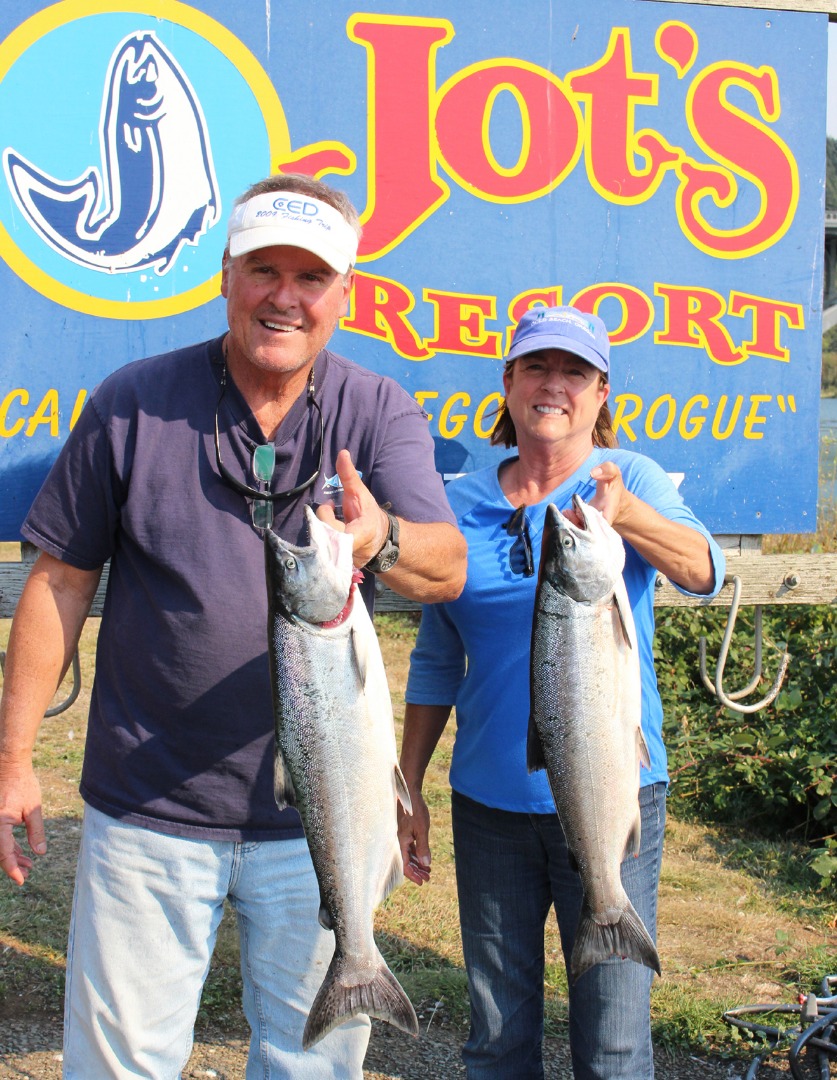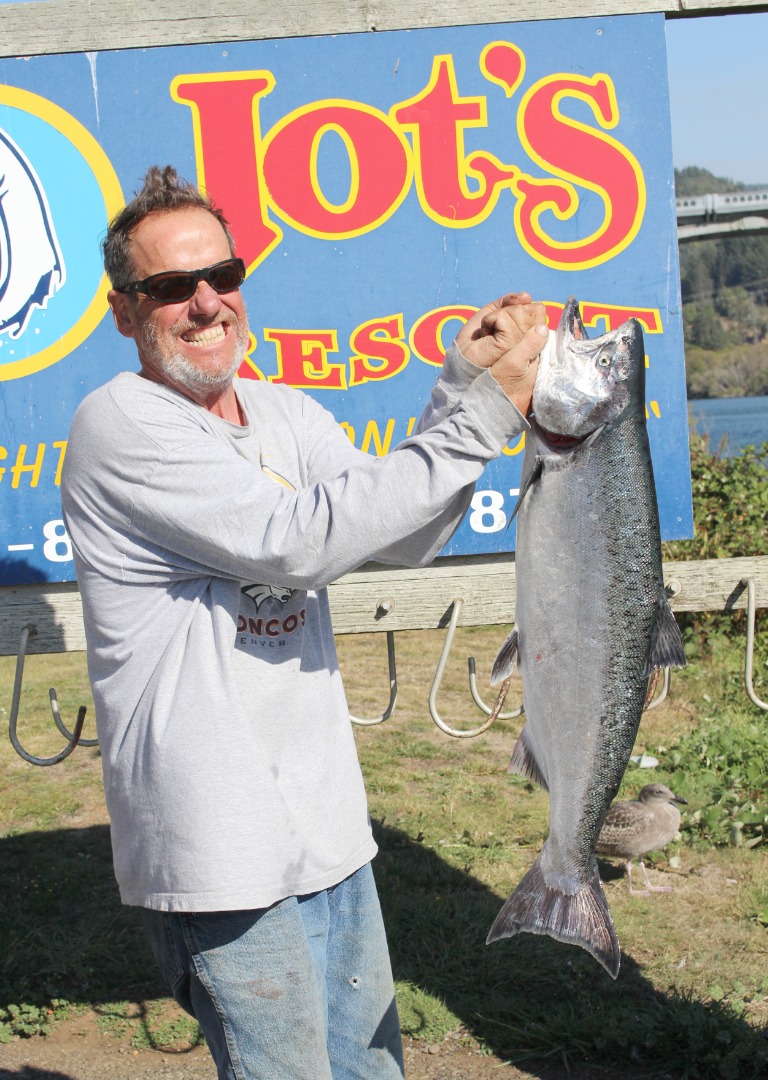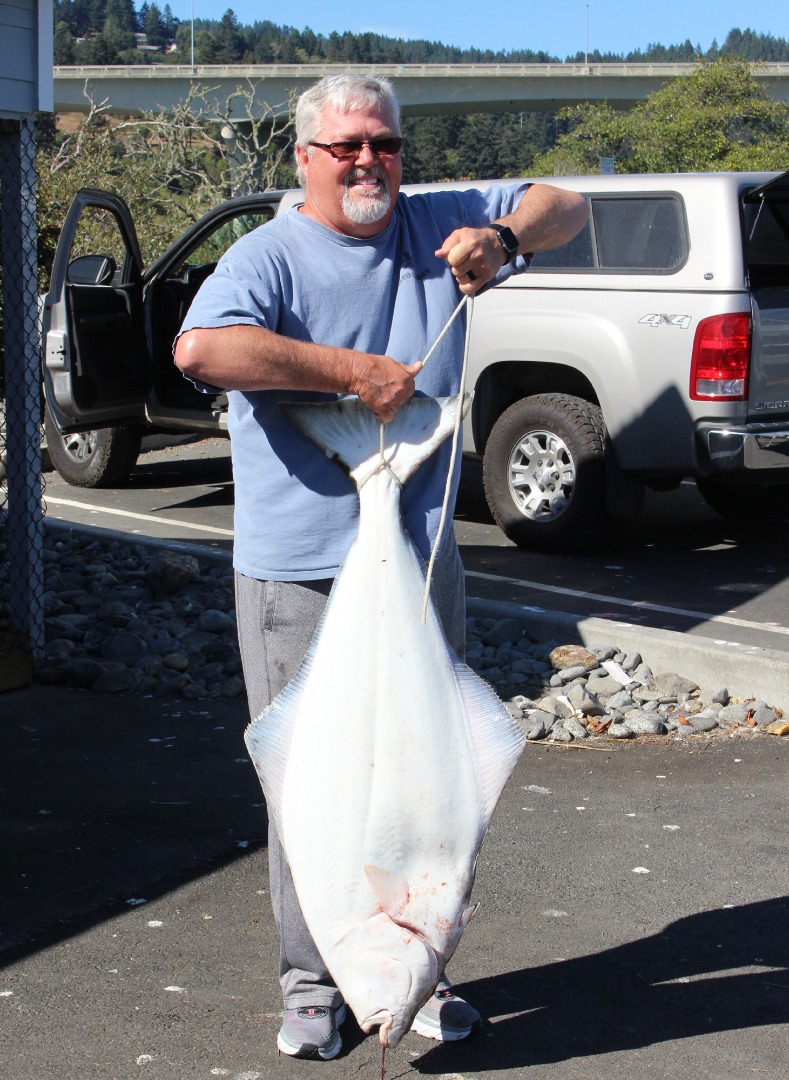Rogue Bay Fish Report for 9-29-2018
Rogue Bay Still Kicking Out Jacks and Jills
Rogue Bay - Gold Beach, OR (Curry County)

by Larry Ellis
9-29-2018
Website
The Rogue bay is still producing enough Chinook to keep boaters trolling in the estuary. The sizes have ranged to jacks to 20-plus pounders. Jacks are by nature, mostly 2-year-old male Chinook under 24 inches. Anything bigger than a jack could be male or female.
On Tuesday, I spent the day on the Rogue observing anglers trolling the bay, and catching three distinct sizes of Chinook - jacks, adults between 8 and 12 pounds, and adults over 20 pounds.
When I had caught up with guide Jack Hanson of Jack's Guide Service, he had three fish on board.
"And one of them was pretty good size," noted Hanson of his 20-plus pounder. "But there were a few bigger ones getting caught.
The Sea Lion Patrol, a group of people dedicated to hazing annoying seals and sea lions, had a boat out in the bay chucking seal bombs at any annoying pinniped that reared its ugly head at a hooked salmon.
On this particular day, the SLP was on point at the river mouth, keeping guides like Mark Van Hook from losing their clients' fish. And the fishing just kept improving, with jack and adult Chinook, as well as silvers being caught as well (only hatchery, adipose fin-clipped coho may be kept).
"We've had an extraordinary day today," said Jim Carey from the Rogue Outdoor Store on Thursday. "We had lots of fresh fish come in of all shapes and sizes and of course we've had a huge run of jacks come in as well. I had several guides limited and off the river in a couple of hours today!"
Carey also reported that there were also coho being caught as well as fin-clipped Chinook. Any fin-clipped king is probably an Indian Creek fish, so those puppies are starting to return to the Indian Creek Hatchery as well.
So it may be well worthwhile for bank fishermen on the south side of the Rogue just downriver from Indian Creek to cast Mepps Flying C's, Panther Martins, 1-ounce Krocodiles and 3/4-ounce Kastmasters.
Play the Daily Double Outside the Port of Brookings
Crabbers who have been soaking their pots for four to five hours and then fishing local reefs have been nailing bucketfuls of Dungeness crab in the 6-1/2 to 8-inch range. The best bait of course has been tuna carcasses, if you are lucky enough to find them. But any rockfish or lingcod carcass found in the fish barrels have been productive for the most part.
Limits or near-limits of the Dungees are common!
Anglers playing the daily double have been soaking their pots for the crab, after which they have been hammering limits of rockfish and lingcod. Some of the lings have been enormous.
"I've been only soaking my pots for four hours," says guide Dave Castellanos from Brookings Ocean Fishing. "And we've got limits or near limits of Dungeness most of the time.
You only have a few short weeks to cash in on the crab fest. The last day of the season will be on October 15.
Klamath River Inundated by Chinook
I can't let this report go on for too long, because a lot of my guide friends are traveling across the border to California to cash in on some fantastic king action on the Klamath.
The Preseason Forecast of salmon ocean abundance was spot on with 3-year-old ocean fish, the reason being that the ocean was just replete with 3-year-old kings. Then there were the surprisingly high amounts of salmon in the 20- to 22-inch range that were caught in the ocean as well.
The accuracy of the 2018 Preseason Forecast was also doubly verified by the amounts of 2- and 3-year-old Chinook that are now returning to the Klamath as we speak, and were being caught like gangbusters by California and Oregon river guides.
Remember though, that all adult Chinook on the Klamath must be released. It is also a barbless hook fishery.
"The Klamath has been just incredible," says Hanson. "I have never seen it like this. I don't know how many fish we had on with three rods. We would have 30-, 40-, or 50-fish that were averaging between 7 to 12 pounds.
"You had to release all the adults. I didn't even want to keep the jacks - just let 'em all go! On some days you would have tons of jacks, while on other days there were just adults. They were just everywhere. I wonder how many fish were swimming up that river? In the last two weeks, I would bet that 100,000 fish-plus came up that river. Everybody was hooking the #%$& out of 'em. It was just crazy!"
This inundation of 2-and 3-year old Chinook will definitely be a plus for next year's 3- and 4-year old kings that will be swimming in the ocean.
Gear Up for the Chetco Bubble Fishery
This coming Friday and Saturday, October 6 and 7, anglers will have one of the last chances at catching a large Chinook in the ocean, in what ODFW officially calls, "The Chetco River Fall Chinook State Waters Terminal Area Season".
The locals just call it "The Chetco Bubble Fishery".
This is an ocean season, so don't be misled by the term 'Chetco River This is a state-run fishery that takes place in state waters, that is, between zero and three miles from shore. It's called a terminal area season because it is focusing on Chetco River Chinook that will be mulling around outside the Chetco River jaws, ready to make their final (terminal) push into the Chetco River bay and river.
This year, just like last year, this season will be restricted to two days of fishing in the ocean for two weekends. It takes place in state waters from Twin Rocks south to the Oregon/California border.
Ocean fishermen are looking forward to a great bubble fishery because already, there have been multiple 10-plus fish days in the Chetco estuary, and there have been multiple 30-pound-plus kings reported to have been caught as well.
So I am of the opinion that the Chetco bubble fishery should be nothing short of spectacular this season.
Anglers will be focusing on three different areas.
The first area will be approximately one-half mile from the jaws, at or around the red can buoy, also known as the bell buoy. This will be a good area to troll around especially when the wind kicks up a notch, but it can also be very productive around the crack of dawn.
The second most-popular trolling area will be paralleling Sporthaven Beach, just outside the breakers, depending on how high the swells are. In this area, the salmon will be right on the bottom, rubbing their bellies in the sand. In fact, when you catch one of these Chinook, they will often have reddened bellies, due to being very close to the bottom.
The third most popular area will be starting between the red can buoy and the whistle buoy, and trolling uphill to an area between 90 and 140 feet. Downriggers are a very popular setup for this area, and the salmon might be near the bottom or they could be suspended.
All in all, you don't usually have to travel very far to get a hookup from one of these fish, which often attain sizes approaching 50 pounds.
Most anglers will be using downriggers, spinning an anchovy behind a flasher or a dodger. It is my personal preference to use a chartreuse Bechhold Rotary Bullet Baitholder to attain this spin, which should be trolled anywhere from 1.8 to 2.3 knots.
My personal setup of choice is to use an 8-inch chrome dodger tied to the end of my 65-pound Power Pro braid being used for my mainline. I will use a leader that's exactly 34-inches long, because that is exactly the length that is required to impart that wicked back-and-forth motion to the anchovy while it is spinning.
I also like to use the Brad's green-colored tape on both sides of the flasher.
If your boat doesn't have a downrigger system, you can also use a Delta Diver to get your bait to your desired depth, but I will still use the Bechhold Bullet to spin my anchovy.
If your depth finder is marking lots of salmon, but you are still not getting bit, only then will I resort to using a cut-plug herring, deployed on a 2 hook mooching rig. But remember that when using cut-plugs, be they herring or sardines, you must slow your troll down, depending on the strength of the current.
How fast you troll depends on the speed that is required to get your cut-plug spinning nice and tight - no more, no less.
If the current is going with you, you may have to troll a little faster. Conversely, if the current is going against you, you will have to troll a little slower. Anyway you slice it, you will always troll a cut-plug baitfish slower than whole baitfish, because as everyone knows, if you troll cut-plugs too fast, they will get torn to shreds in very little time.
Tight lines!
Larry Ellis, author, writer, columnist and photographer has had a 50-year passion for fishing in California and Oregon's saltwater and freshwater venues. He is a well-known writer for Oregon, Washington and California Fishing and Hunting News, Northwest Sportsman, California Sportsman and Pacific Coast Sportfishing. He currently writes monthly for Salmon Trout Steelheader Magazine, and is the author of two books, "Plug Fishing for Salmon" and "Buoy 10, the World's Largest Salmon Run." Both books can be bought from Amato Publications (amatobooks.com), Amazon and eBay. Ellis particularly loves living in his hometown of Brookings, Oregon - The heart of salmon country and gateway to fishing paradise.
More Reports
Anglers Continue to Haul in Chinook in the Rogue and Chetco Bays
Rogue Bay
9-21-2018
The Rogue bay and Chetco bay continue to please anglers as they continued to catch a variety of Chinook sizes...... Read More
The Spinnerbait Rig - The Rogue and Chetco Bays' Premier Setup
Rogue Bay
9-15-2018
Fall is in the air, and Chinook in southern Oregon bays are falling for the spinnerbait/anchovy rig. If you know how...... Read More

Website Hosting and Design provided by TECK.net